GeoBioScience: Red Wood Ants as Bioindicators for Active Tectonic Fault Systems in the West Eifel (Germany)
Simple Summary
Abstract
1. Introduction
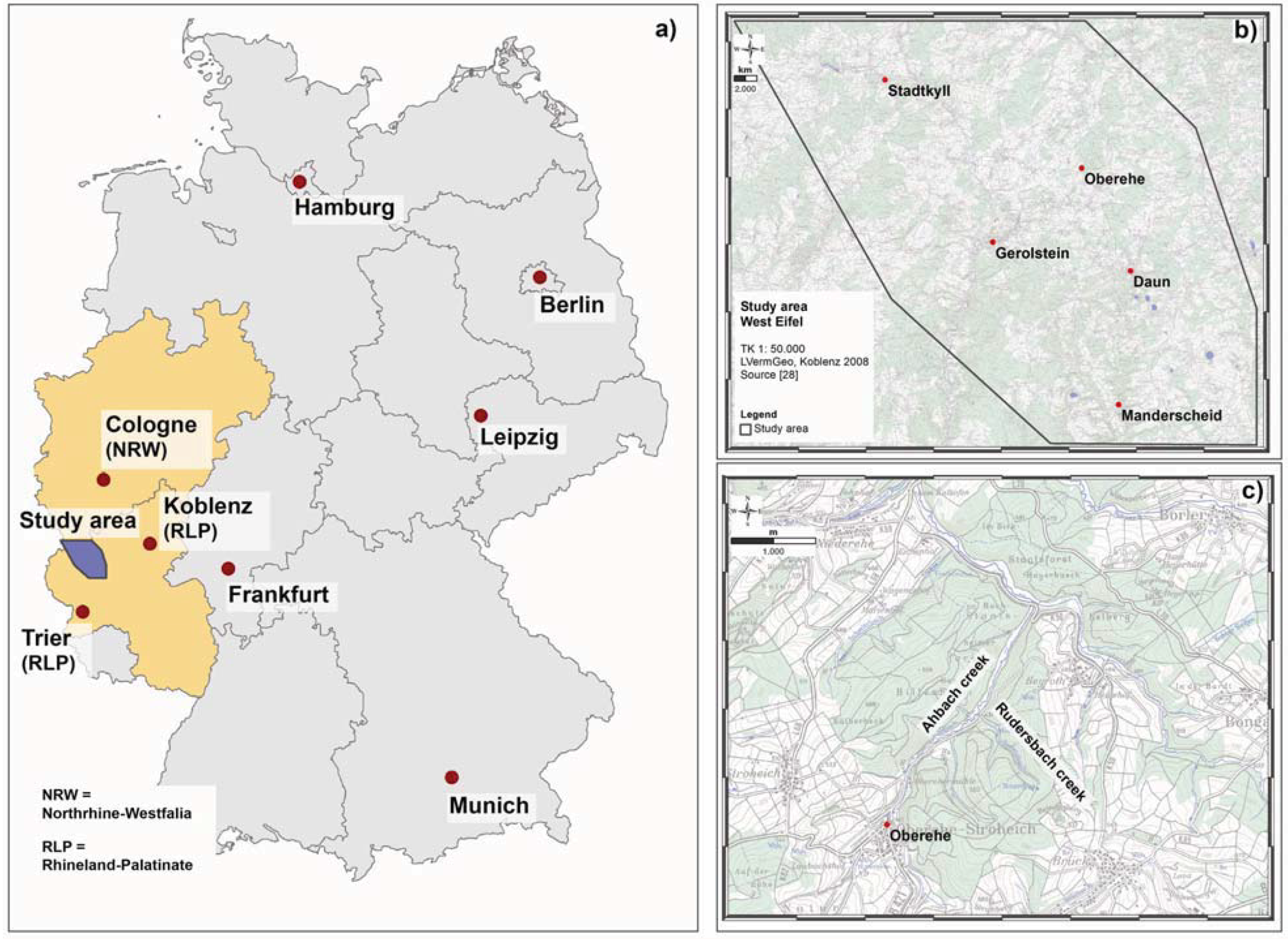
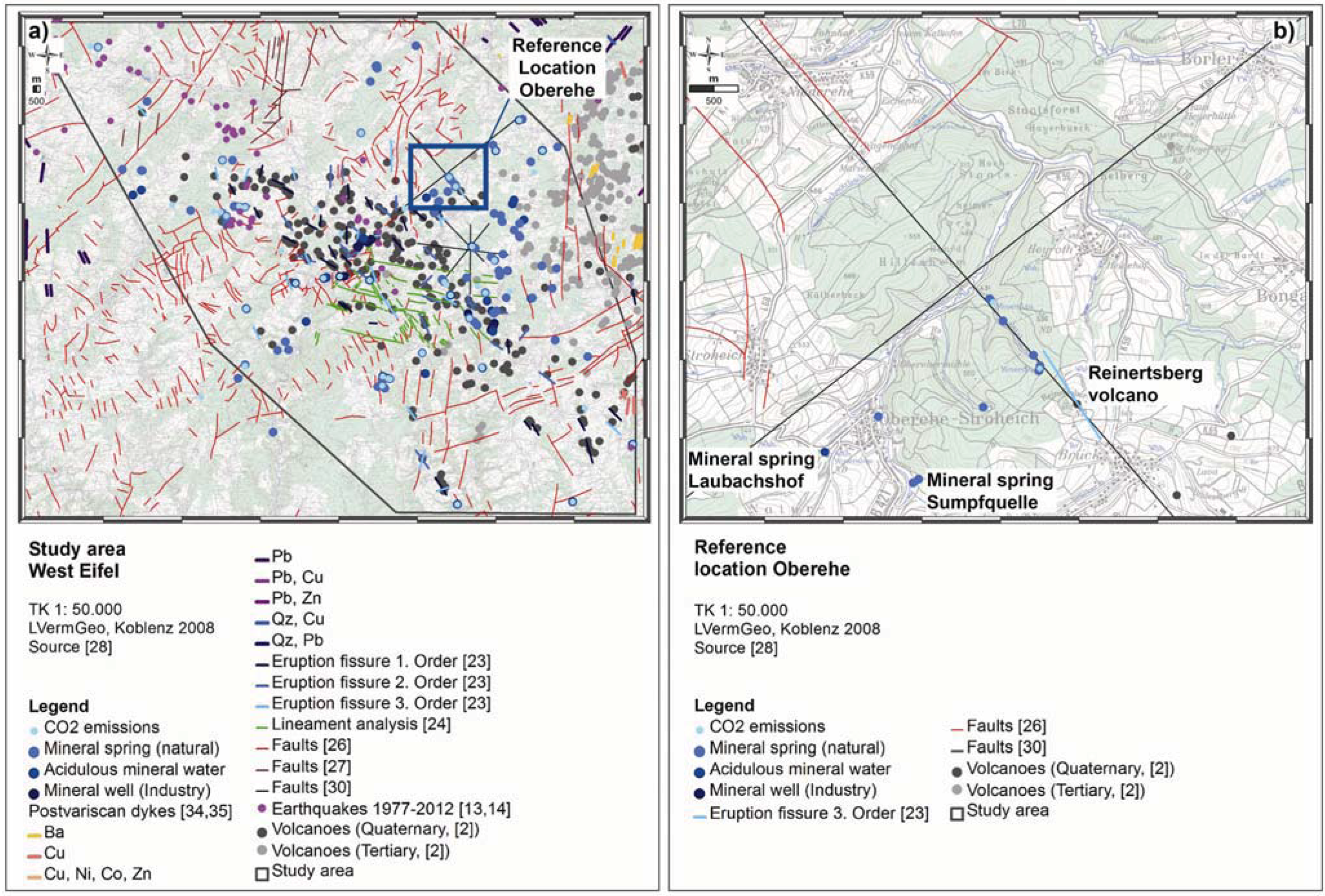
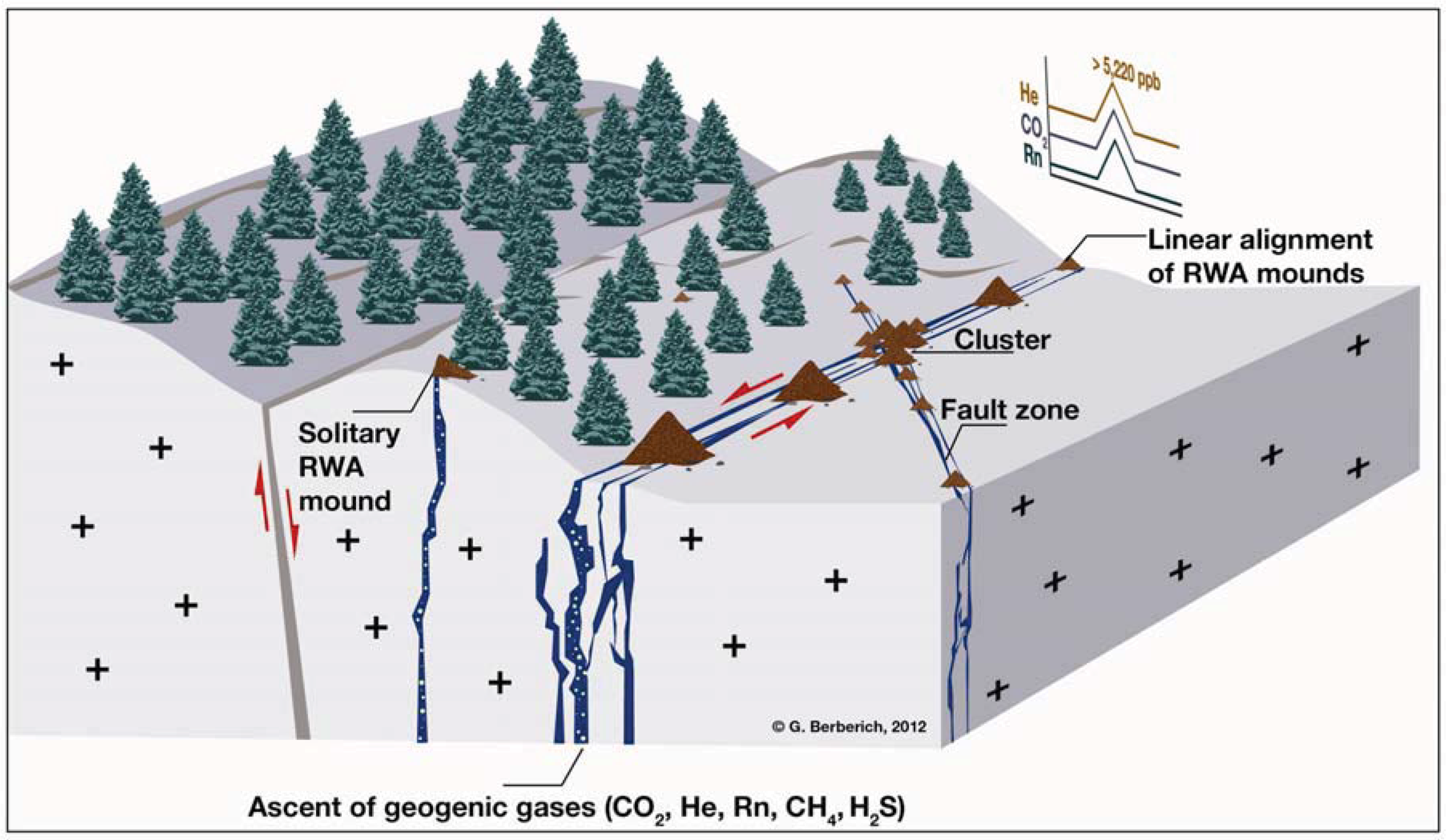
2. Materials and Methods
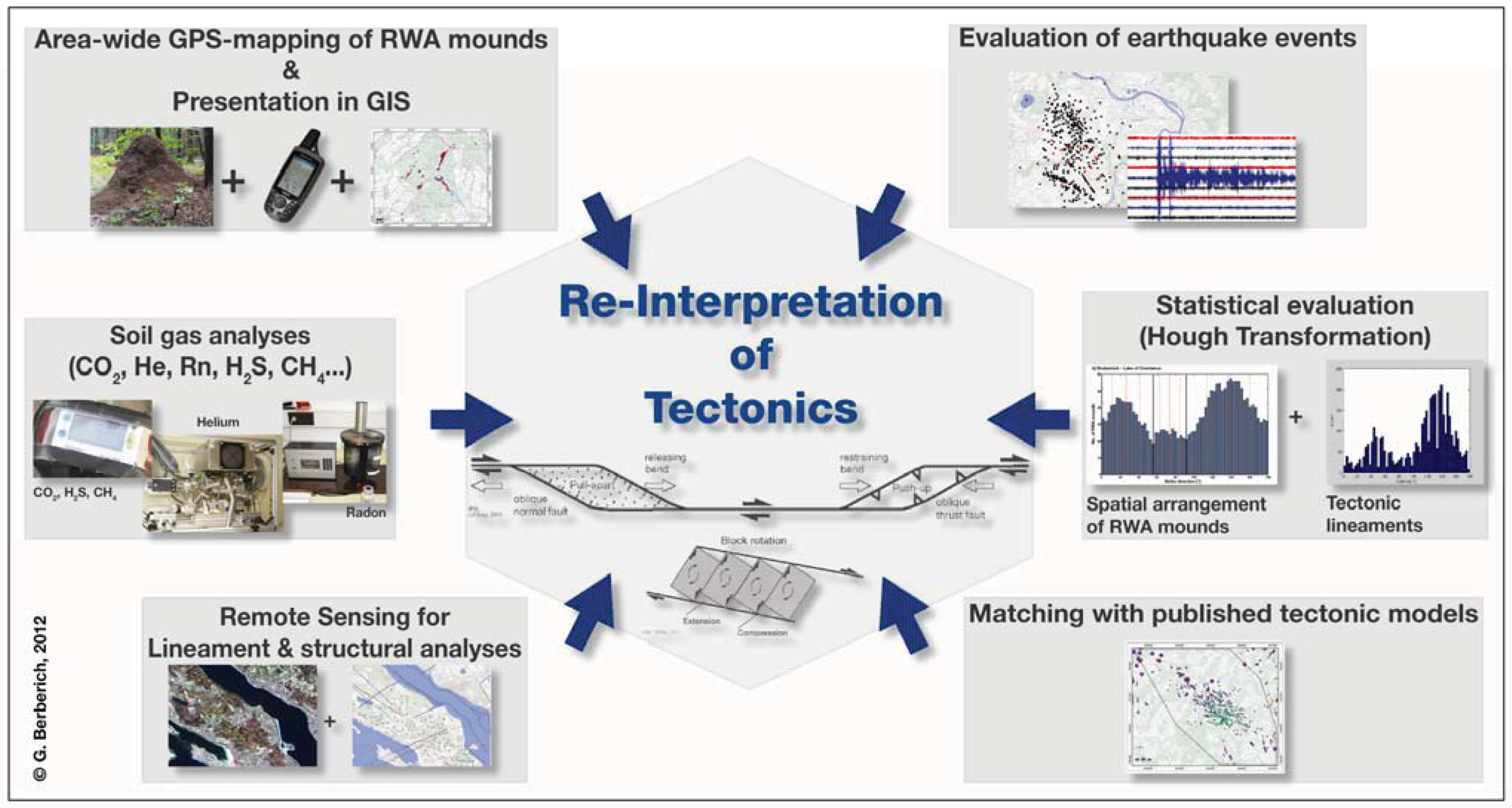
2.1. Mapping and Data Collection
2.2. Gas Samples and Analyses
3. Results and Discussion
3.1. Spatial Distribution Pattern of RWA in the Study Area and at the Reference Location Oberehe
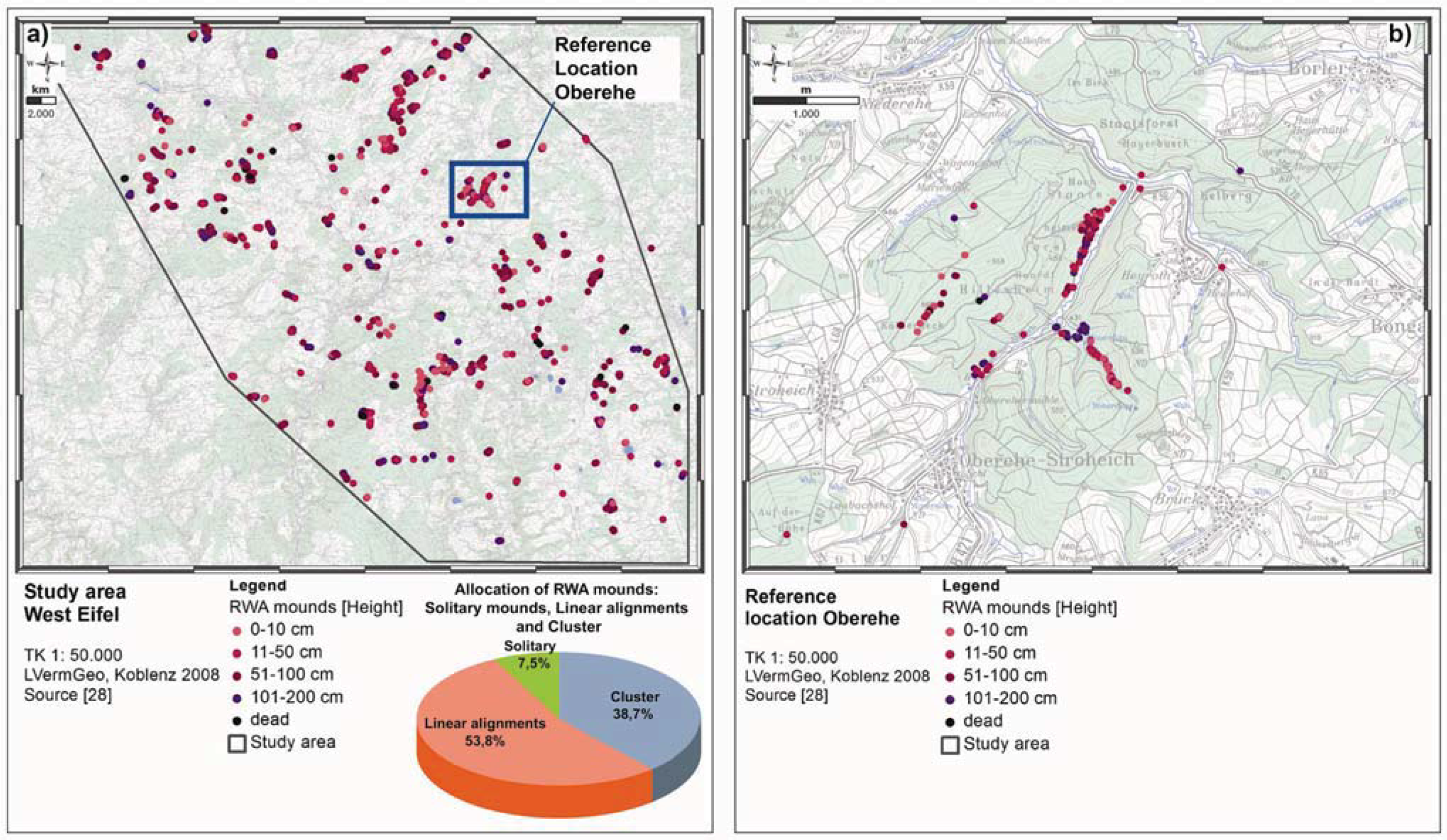
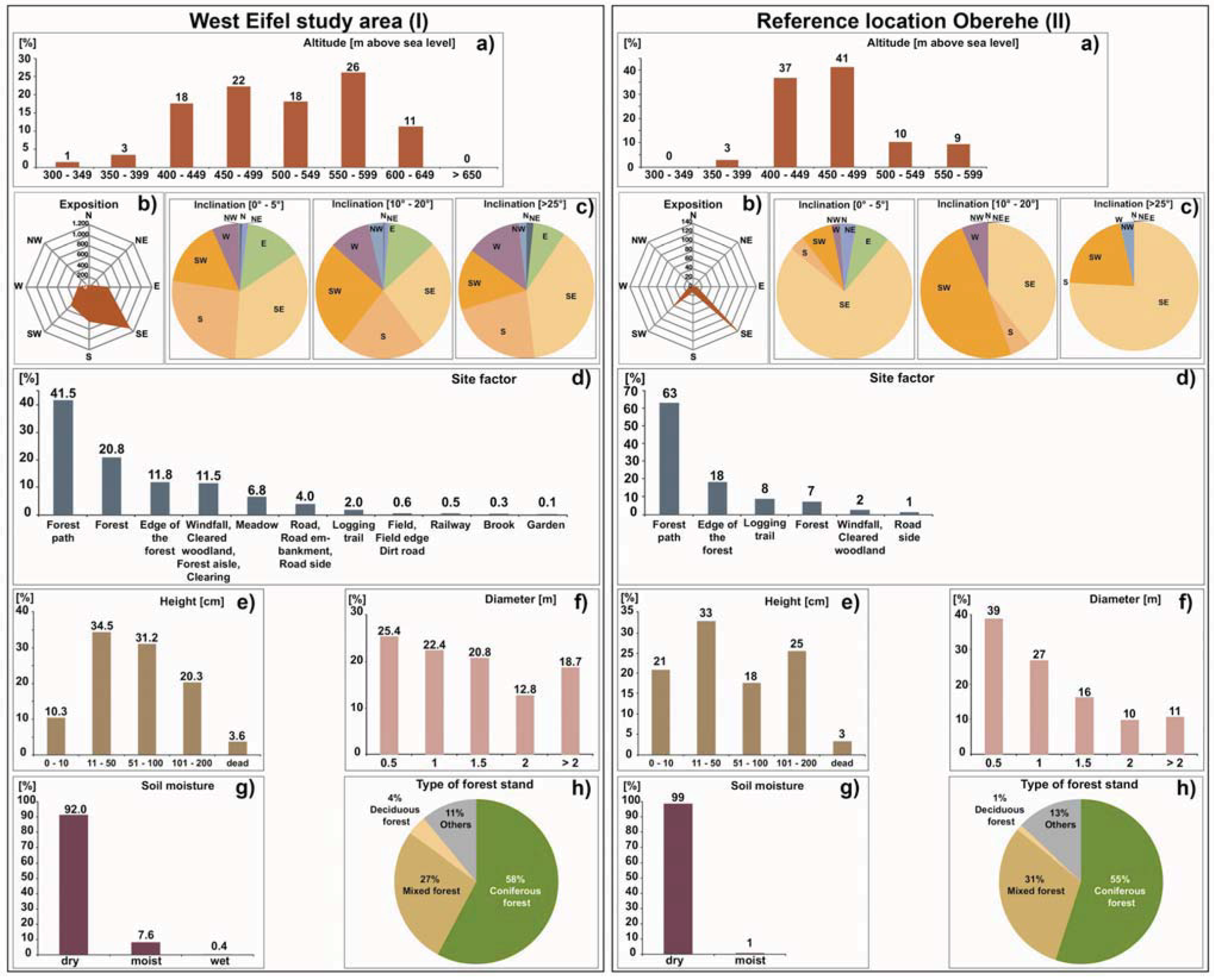
| Author | Year | Area | Sum | Recent mapping [28] | Factor |
|---|---|---|---|---|---|
| Wellenstein [60] | 1960–1968 | Daun region | 562 | 988 | 1.75 |
| Moelter [61] | 1984 | Kelberg, Adenau | 356 | 1,408 | 3.95 |
| Forest Office Salm [62] | 1991 | Salm Forest | 66 | 128 | 1.94 |
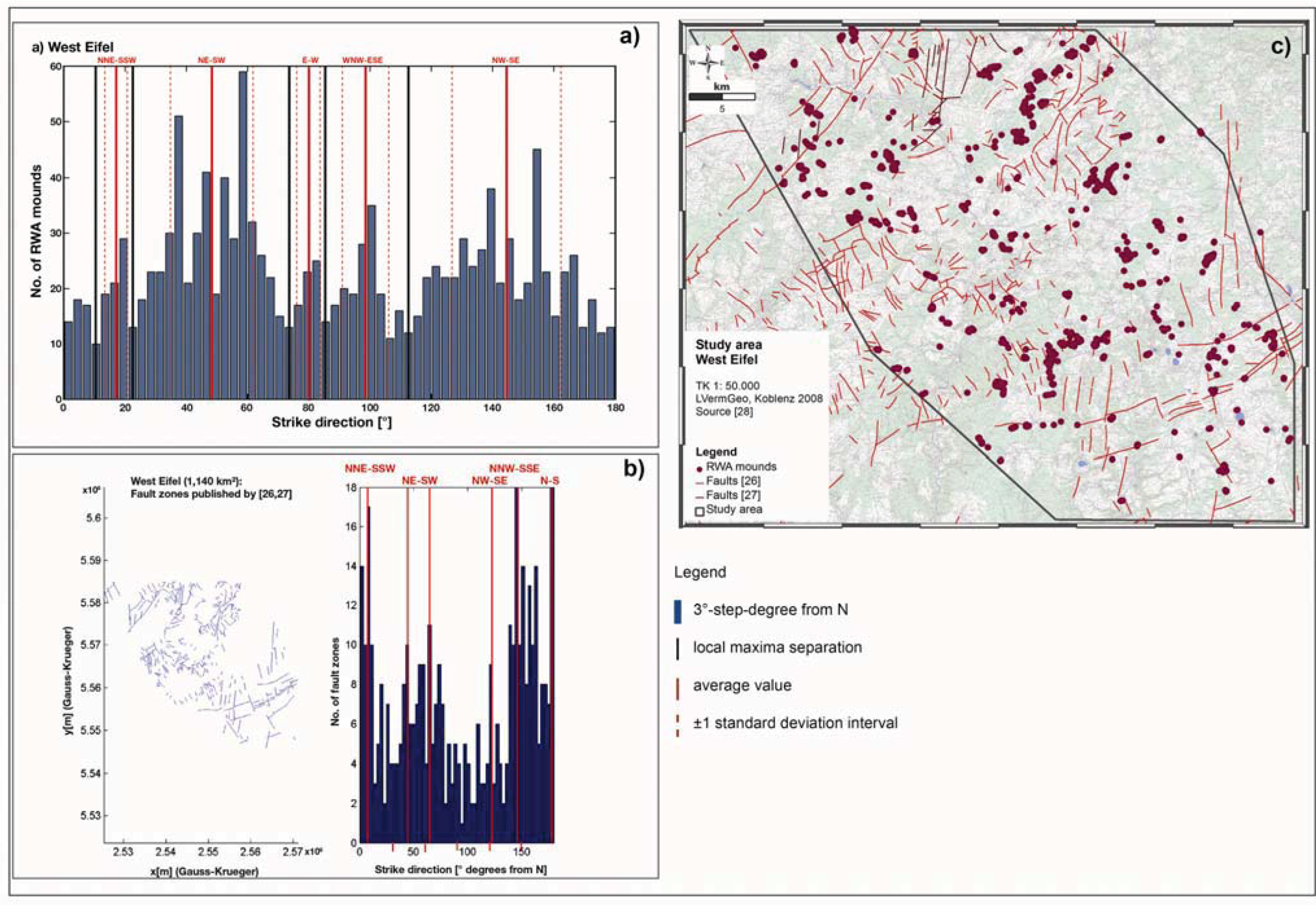
3.2. Geogenic Gas Concentrations in the Study Area and Anomalies
3.2.1. Gas Concentrations in Minerals Springs and Mofettes of the Study Area
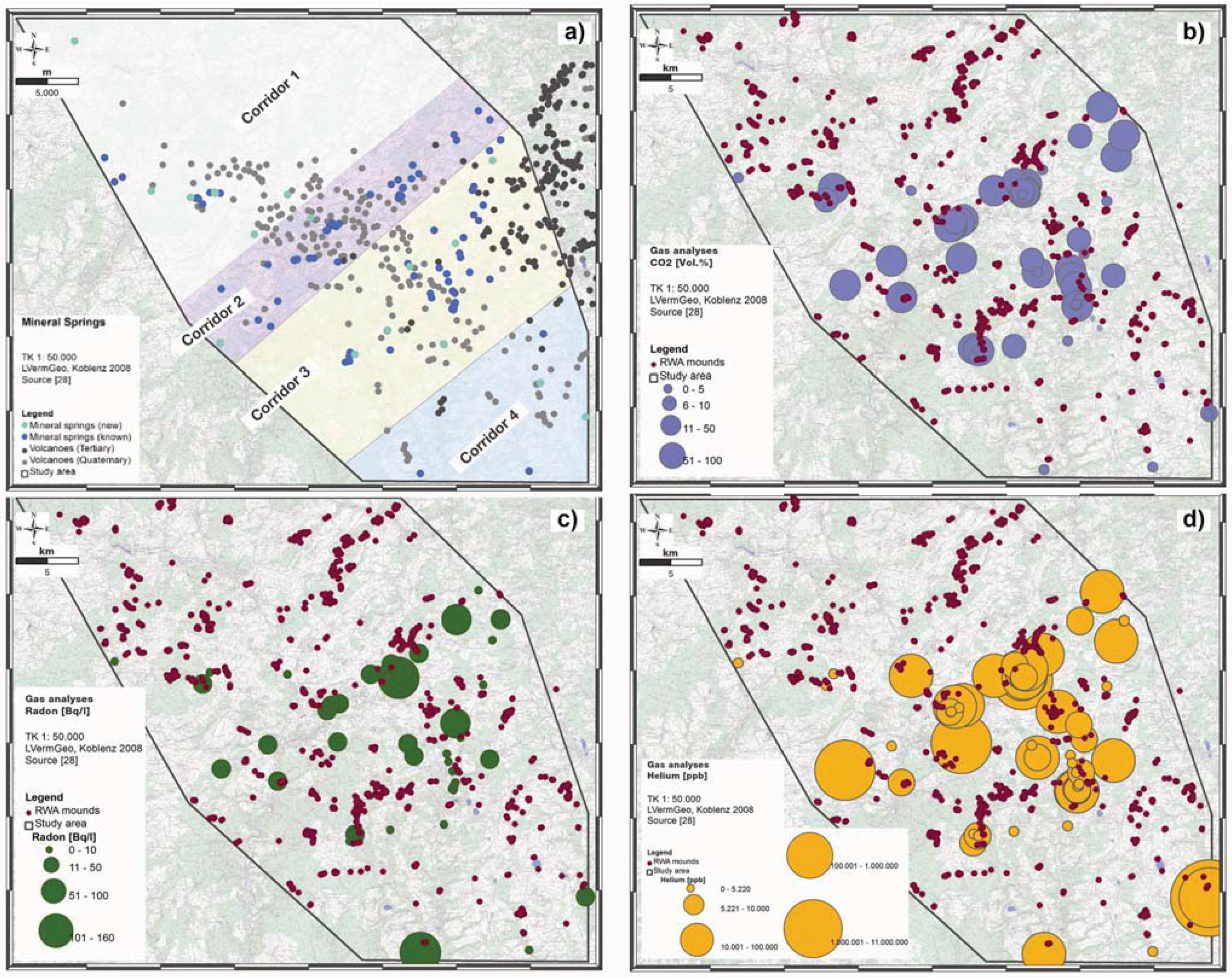
3.2.2. Gas Concentrations and Anomalies at Oberehe
| Entire study are (gas analyses from mofettes and mineral springs) [28] | Reference location Oberehe (soil gas analyses) [28] | |||||||||
|---|---|---|---|---|---|---|---|---|---|---|
| CO2 [Vol%] | He [ppb] | Rn [Bq/L] | CH4 [ppm] | H2S [ppm] | CO2 [Vol%] | He [ppb] | Rn [Bq/L] | CH4 [ppm] | H2S [ppm] | |
| N | 42 | 58 | 55 | 58 | 3 | 126 | 127 | 128 | 128 | 128 |
| Mean | 59 | 256,884 | 25 | 0 | 4 | 2 | 5,247 | 13 | 0 | 0 |
| Median | 73 | 8,357 | 10 | 0 | 2 | 1 | 5,236 | 9 | 0 | 0 |
| Min. | 2 | 2,033 | 0 | 0 | 2 | 0 | 4,941 | 0 | 0 | 0 |
| Max. | 84 | 10,523.427 | 152 | 0 | 8 | 14 | 5,636 | 74 | 0 | 0 |
| LQ | 43 | 3,835 | 5 | – | 2 | 0 | 5,197 | 3 | – | – |
| UQ | 80 | 21,190 | 33 | – | 5 | 2 | 5,276 | 18 | – | – |
| IQR | 37 | 17,355 | 28 | – | 3 | 1 | 80 | 60 | – | – |
| StD | 25 | 1,418.216 | 34 | – | 3 | 2 | 97 | 15 | – | – |
| Skewness | -1 | 7 | 2 | – | 2 | 3 | 1 | 2 | – | – |
| Atmospheric standard | 0.037 | 5,220 | 0.01 | 1.5 | 0.002 | 0.037 | 5,220 | 0.01 | 1.5 | 0.002 |
| Average regional background value | – | – | – | – | – | 5,202 [28] | 46 [56] | – | – | |
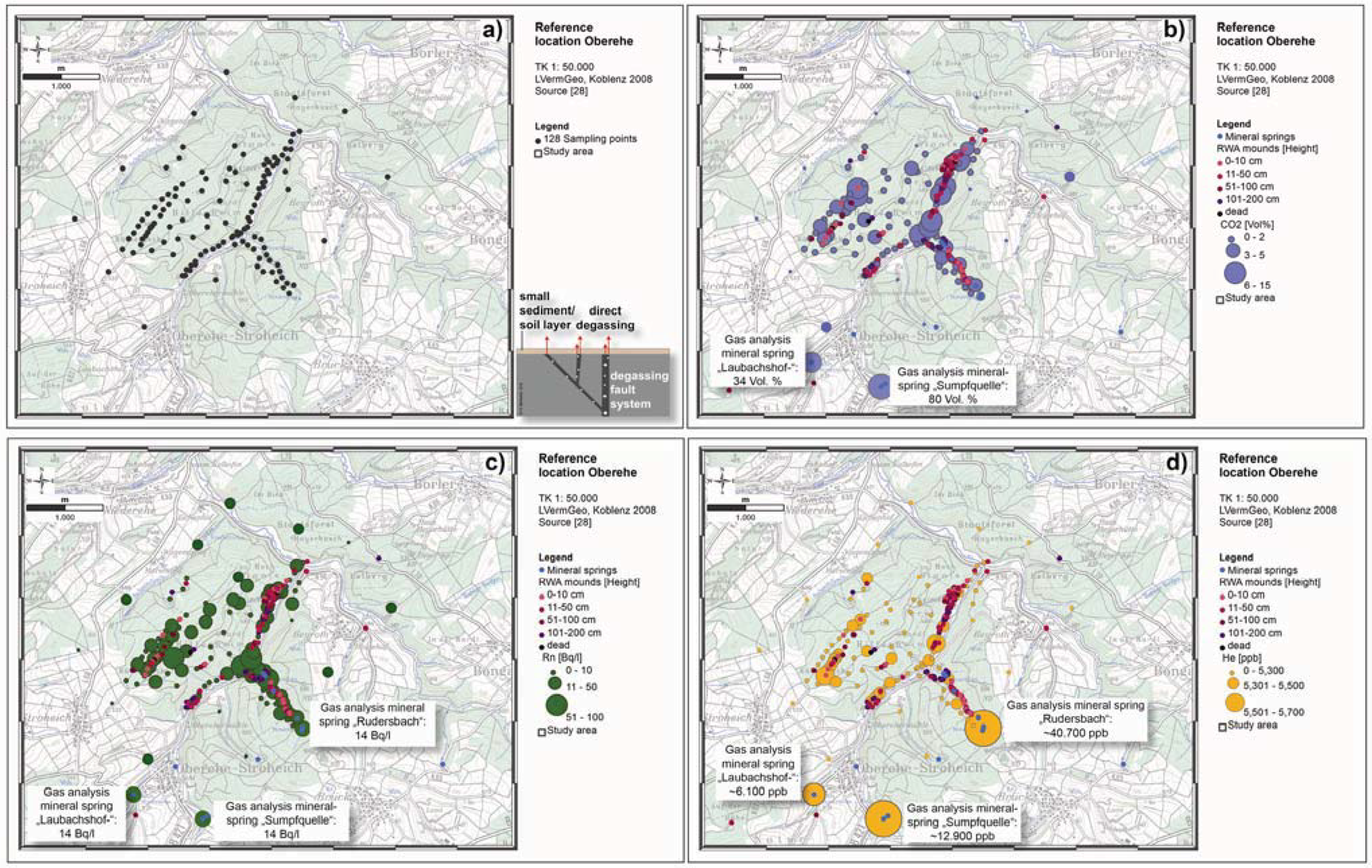
3.2.3. Correlation of RWA Mounds and Gas Concentrations at the Reference Site Oberehe
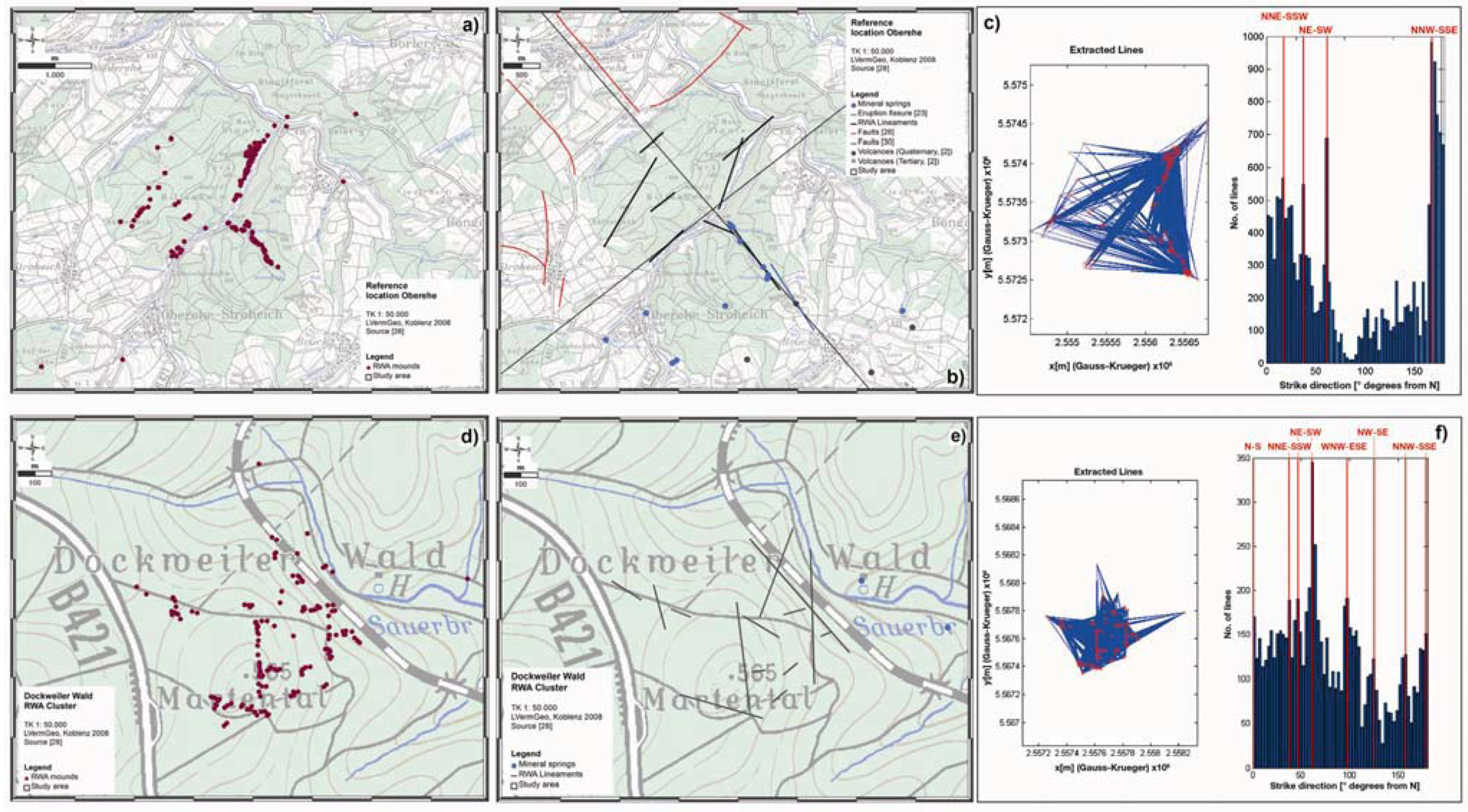
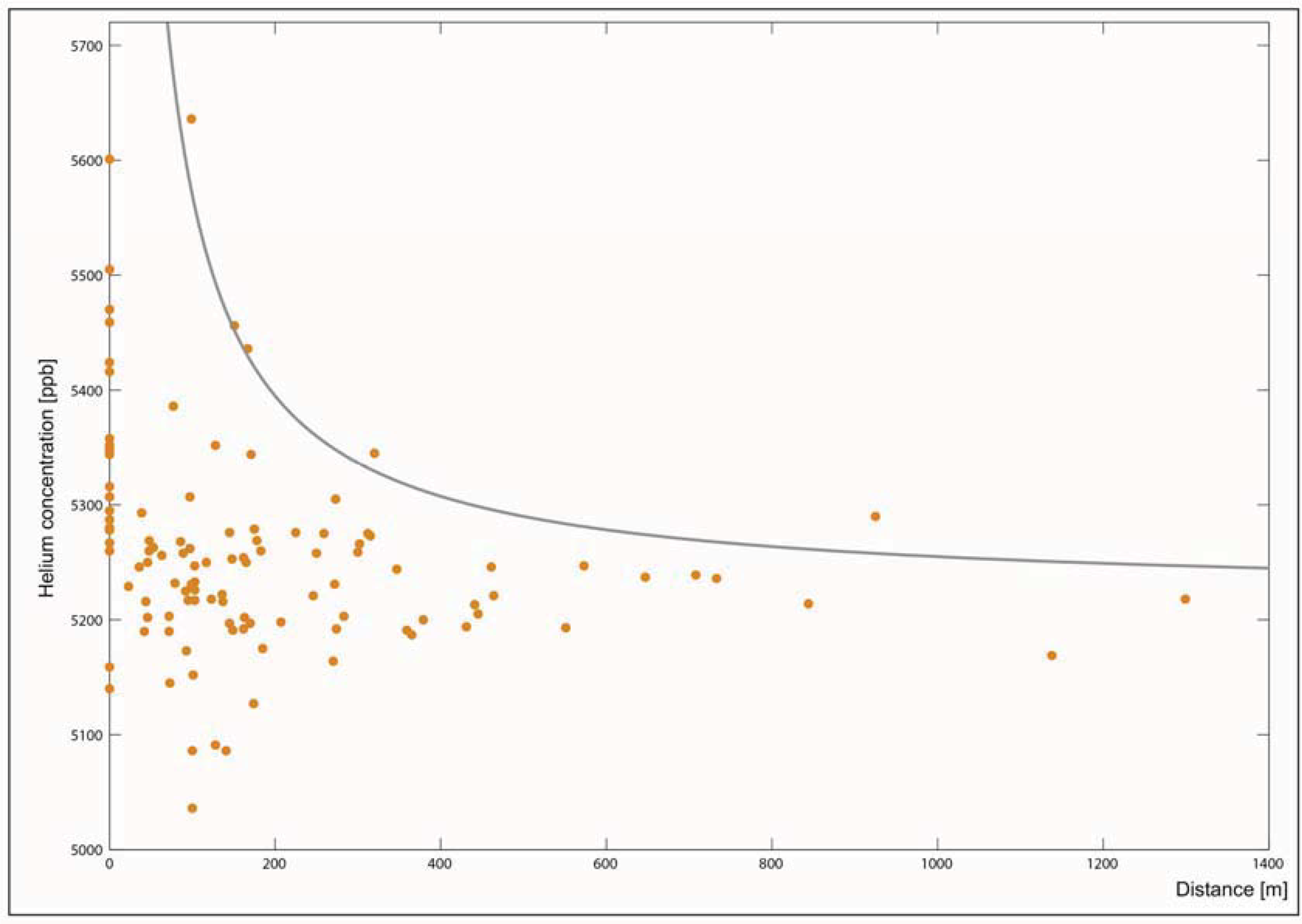
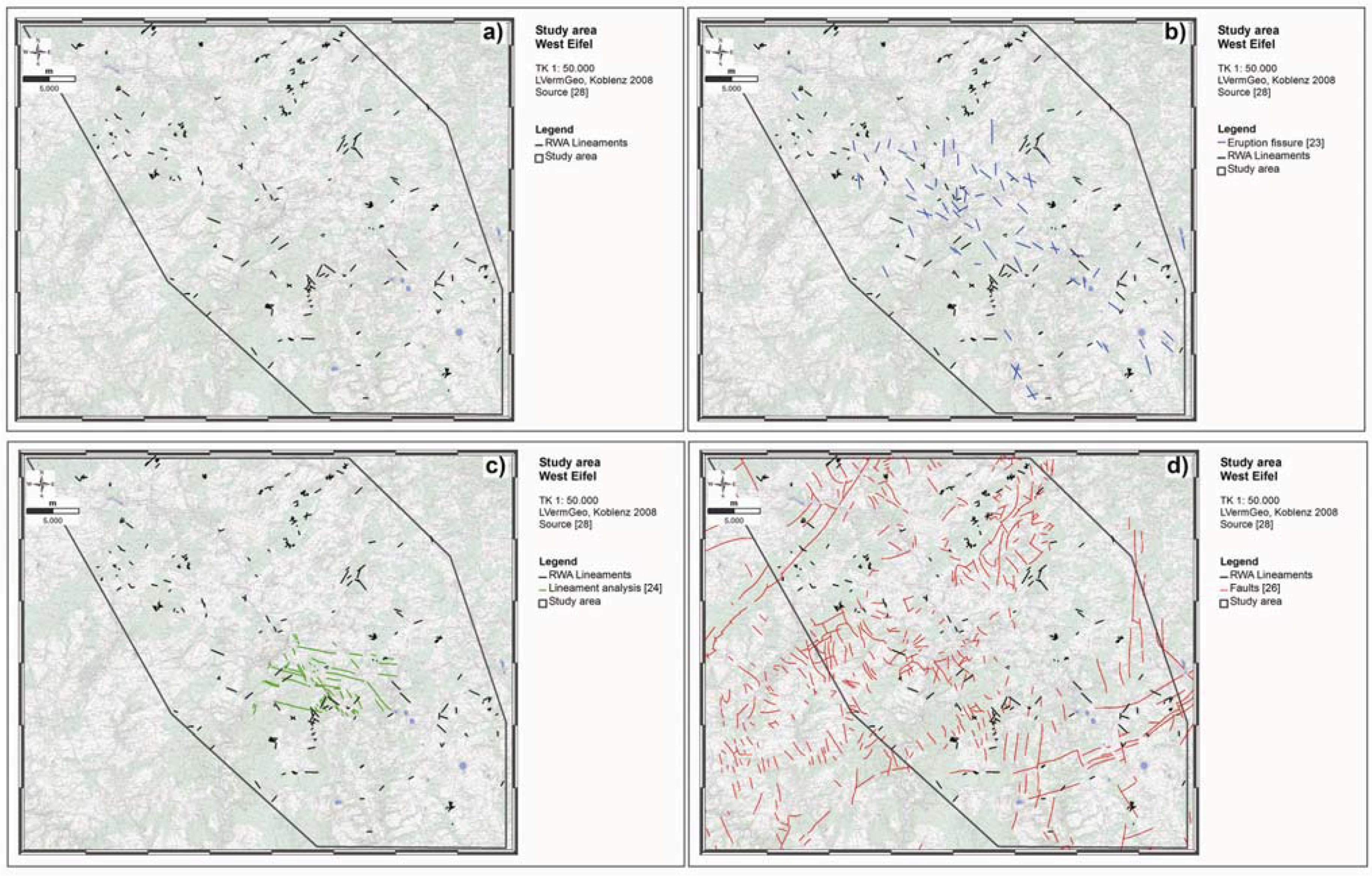
4. Conclusions
Acknowledgments
Conflict of Interest
References and Notes
- Meyer, W. Geologie der Eifel, 3rd ed.; E. Schweizerbart‘sche Verlagsbuchhandlung: Stuttgart, Germany, 1994; p. 618. [Google Scholar]
- Seib, N.; Kley, J.; Torizin, J.; Zander, I.; Goepel, A.; Büchel, G. Identifikation vulkanischer Formen in einem digitalen Geländemodell (DGM) der Westeifel. Z. dt. Ges. Geowiss 2008, 159, 657–670. [Google Scholar]
- Landesamt für Geologie und Bergbau Rheinland-Pfalz (LGB-RLP), Geologie von Rheinland—Pfalz, 1st ed.E. Schweizerbart‘sche Verlagsbuchhandlung: Stuttgart, Germany, 2005; p. 400.
- Betz, D.; Führer, F.; Greiner, G.; Plein, E. Evolution of the Lower Saxony Basin. Tectonophysics 1987, 137, 127–170. [Google Scholar] [CrossRef]
- Schreiber, U.; Rotsch, S. Cenozoic block rotation according to a conjugate shear system in central Europe—Indications form paleomagnetic measurements. Tectonophysics 1998, 299, 111–142. [Google Scholar] [CrossRef]
- Loos, J.; Juch, D.; Ehrhardt, W. Äquidistanzen von Blattverschiebungen: neue Erkenntnisse zur Lagerstättenbearbeitung im Ruhrkarbon. Z. f. angew. Geol. 1999, 45, 26–36. [Google Scholar]
- Campbell, J.; Kümpel, H.-J.; Fabian, M.; Fischer, D.; Görres, B.; Keysers, C.J.; Lehmann, K. Recent movement pattern of the Lower Rhine Embayement from tilt, gravity and GPS data. Neth. J. Geosci. 2002, 81, 223–230. [Google Scholar]
- Hinzen, K.G. Stress field in the Northern Rhine area, Central Europe, from earthquake fault plane solutions. Tectonophysics 2003, 377, 325–356. [Google Scholar] [CrossRef]
- Dèzes, P.; Schmid, S.M.; Ziegler, P.A. Evolution of the European Cenozoic Rift System: Interaction of the Alpine and Pyrenean orogens with their foreland lithosphere. Tectonophysics 2004, 389, 1–133. [Google Scholar] [CrossRef]
- Walker, K.T.; Bokelmann, G.H.R.; Klemperer, S.L.; Bock, G. Shear-wave splitting around the Eifel hotspot: Evidence for a mantle upwelling. Geophys. J. Int. 2005, 163, 962–980. [Google Scholar] [CrossRef]
- Tesauro, M.; Hollenstein, C.; Egli, R.; Geiger, A.; Kahle, H.-G. Analysis of central western Europe deformation using GPS and seismic data. J. Geodynam. 2006, 42, 194–209. [Google Scholar] [CrossRef]
- Meyer, W.; Stets, J. Pleistocene to Recent tectonics in the Rhenish Massif (Germany). Neth. J. Geosci. 2002, 81, 217–221. [Google Scholar]
- Earthquake Data Catalogue. Department of Earthquake Geology of Cologne University. Available online: http://www.seismo.uni-koeln.de/catalog/index.htm (11 September 2012).
- Earthquake Catalogue. Landesamt für Geologie und Bergbau Rheinland-Pfalz, 10 09 2009. Available online: http://www.lgb-rlp.de/erdbeben.htm (accessed on 9 October 2009).
- Rummel, F.; Baumgärtner, J. Hydraulic fracturing in-situ stress and permeability measurements in the research borehole Konzen, Hohes Venn (West Germany). N. Jb. Geol. Paläont. Abh. 1985, 171, 183–193. [Google Scholar]
- Ahorner, L. Present-day stress field and seismotectonic block movements along major faults in Western Europe. Tectonophysics 1975, 29, 233–249. [Google Scholar] [CrossRef]
- Illies, J.; Baumann, H. Crustal dynamics and morphodynamics of the Western European Rift System. Z. Geomorph. (Suppl.) 1982, 42, 135–165. [Google Scholar]
- Griesshaber, E.; O’Nions, R.K.; Oxburgh, E.R. Helium and carbon isotope systematics in crustal fluids from the Eifel, the Rhine Graben and Black Forest, F.R.G. Chem. Geol. 1992, 99, 213–235. [Google Scholar] [CrossRef]
- Aeschbach-Hertig, W. Helium und Tritium als Tracer für physikalische Prozesse in Seen. Ph.D. Thesis, ETH Zürich, Zürich, Switzerland, 1994. [Google Scholar]
- Griesshaber, E. The distribution pattern of mantle-derived volatiles in mineral waters of the Rhenish Massif. In Young Tectonics – Magmatism – Fluids, a Case Study of the Rhenish Massif; Neugebauer, H.J., Ed.; Schriftenreihe Sonderforschungsbereich 350: Bonn, Germany, 1998; Volime, 74, pp. 51–59. [Google Scholar]
- Clauser, C.; Griesshaber, E.; Neugebauer, H.J. Decoupled thermal and mantle helium anomalies: Implications for the transport regime in continental rift zones. J. Geophys. Res. 2002, 107, 1–16. [Google Scholar]
- Büchel, G.; Mertes, H. Die Eruptionszentren des Westeifeler Vulkanfeldes. Z. Dt. Geol. Ges. 1982, 133, 409–429. [Google Scholar]
- Schmincke, H.-U. Vulkanismus, 2nd ed.; Wissenschaftliche Buchgesellschaft: Darmstadt, Germany, 2000; p. 264. [Google Scholar]
- Hesse, G. Hydrogeologische Erkundung von Maar-Diatrem-Vulkanen am Beispiel des Geeser Maares (Westeifel). Ph.D. Thesis, Universität Jena, Jena, Germany, 2002. [Google Scholar]
- Hart, P.E. How the Hough transform was invented. IEEE Sign. Process. Mag. 2009, 26, 18–22. [Google Scholar] [CrossRef]
- Zitzmann, A.; Grünig, S. Geologische Übersichtkarte Deutschland 1:200 000 (GÜK200); Blatt CC6302 Trier; Staatliche Geologische Dienste der Bundesrepublik Deutschland (SGD) und BGR: Hannover, Germany, 1987. [Google Scholar]
- Ribbert, K.H. Geologische Karte von Nordrhein-Westfalen 1:100.000; Geologisches Landesamt Nordrhein-Westfalen: Krefeld, Germany, 1992; p. 84. [Google Scholar]
- Berberich, G. Identifikation junger gasführender Störungszonen in der West- und Hocheifel mit Hilfe von Bioindikatoren. Ph.D. Thesis, University of Duisburg-Essen, Essen, Germany, 2010. [Google Scholar]
- May, F. Zur Entstehung der Mineralwässer des Rheinischen Massivs. Ph.D. Thesis, Universität Bonn, Bonn, Germany, 1994. [Google Scholar]
- May, F. Quantifizierung des CO2-Flusses zur Abbildung magmatischer Prozesse im Untergrund der Westeifel, 1st ed.; Shaker Verlag: Aachen, Germany, 2002; p. 172. [Google Scholar]
- Berberich, G.; Klimetzek, D.; Wöhler, C.; Grumpe, A. Statistical Correlation between Red Wood Ant Sites and Neotectonic Strike-Slip Faults. In Proceedings of the EGU General Assembly, Vienna, Austria, 22–27 April 2012.
- Weisser, D. Tektonik und Barytgänge in der SE-Eifel. ZDGG 1963, 115, 33–68. [Google Scholar]
- Redecke, P. Zur Geochemie und Genese variszischer und postvariszischer Buntmetallmineralisation in der Nordeifel und der Niederrheinischen Bucht. Ph.D. Thesis, RWTH Aachen, Aachen, Germany, 1992. [Google Scholar]
- Reppke, V. Varistische und postvaristische Buntmetallmineralisationen in der östlichen Eifel (Linksrheinisches Schiefergebirge). Ph.D. Thesis, Universität Göttingen, Göttingen, Germany, 1993. [Google Scholar]
- Landesamt für Geologie und Bergbau Rheinland-Pfalz (LGB-RLP). Gangkarte Hunsrück und Eifel, 1980/2009. Unpublished data, 2009.
- Schreiber, U.; Brennholt, N.; Simon, J. Gas permeable deep reaching fracture zones encourage site selection of ants. Ecol. Ind. 2009, 9, 508–517. [Google Scholar] [CrossRef]
- Erpenbeck, A.; Kirchner, W. Zur Kälteresistenz der Kleinen Roten Waldameise Formica polyctena Foerst. (Hymenoptera, Formicidae). Z. angew. Entomol. 1983, 96, 271–281. [Google Scholar] [CrossRef]
- Hetz, S.K.; Bradley, T.J. Insects breathe discontinuously to avoid oxygen toxicity. Nature 2005, 433, 516–519. [Google Scholar] [CrossRef]
- Hölldobler, B.; Wilson, E.O. Der Superorganismus: Der Erfolg von Ameisen, Bienen, Wespen und Termiten; Springer: Berlin, Germany, 2010. [Google Scholar]
- Camlitepe, Y.; Stradling, D.J. Wood ants orient to magnetic fields. Proc. R. Soc. Lond. 1995, 261, 37–41. [Google Scholar] [CrossRef]
- Camlitepe, Y.; Aksoy, V.; Uren, N.; Yilmaz, A.; Becenen, I. An Experimental Analysis on the Magnetic Field Sensitivity of the Black-Meadow Ant Formica Pratensis Retzius (Hymenoptera: Formicidae). Acta Biol. Hung. 2005, 56, 215–224. [Google Scholar] [CrossRef]
- de Oliveira, J.F.; Wajnberg, E.; de Souza Esquivel, D.M.; Weinkauf, S.; Winklhofer, M.; Hanzlik, M. Ant antennae: Are they sites for magnetoreception? J. R. Soc. Interface 2010, 7, 143–152. [Google Scholar] [CrossRef]
- Gösswald, K. Über Nutzen, Ausrottung, Schutz, Verbreitung und künstliche Vermehrung der Roten Waldameise Formica rufa L. In Jahresber. Berl. u. Brandenburger Provinzstellen f. Naturschutz; Verlag Trowitzsch & Sohn: Frankfurt/Berlin, Germany, 1939; Volume 1, pp. 14–30. [Google Scholar]
- Rammoser, H. Die Verbreitung der hügelbauenden Waldameisen im Spessart. Waldhygiene 1961, 6, 44–82. [Google Scholar]
- Eichhorn, O. Zur Ökologie der Ameisen mitteleuropäischer Gebirgswälder. Post-Doctoral Thesis, Universität Göttingen, Göttingen, Germany, 1962. [Google Scholar]
- Wellenstein, G. Beiträge zur Biologie der Roten Waldameise (Formica rufa L.) mit besonderer Berücksichtigung klimatischer und forstlicher Verhältnisse. Z. angew. Entomol. 1929, 14, 1–68. [Google Scholar] [CrossRef]
- Sauer, G. Kleinstaaterei in Rudolfshagen. Kosmos Das Magazin für die Natur 1983, 79, 68–73. [Google Scholar]
- Klimetzek, D. Zur Bedeutung des Kleinstandortes für die Verbreitung hügelbauender Waldameisen der Formica rufa Gruppe (Hymenoptera: Formicidae). Z. angew. Entomol. 1970, 66, 84–95. [Google Scholar]
- Klimetzek, D.; Kaiser, M. Zur Ökologie der Formica rufa-Gruppe. Waldhygiene 1995, 20, 243–254. [Google Scholar]
- Wellenstein, G. Waldbewohnende Ameisen: ihre Bedeutung, ihre Biologie, ihre Hege und ihr Schutz, 2nd ed.; Allgäuer Zeitungsverlag GmbH: Kempten, Germany, 1990. [Google Scholar]
- Seifert, B. Ameisen beobachten, bestimmen; Natur Buch Verlag: Augsburg, Germany, 1996; p. 352. [Google Scholar]
- Chiodini, G.; Frondini, F.; Ponziani, F. Deep structures and carbon dioxide degassing in Central Italy. Geothermics 1995, 24, 81–94. [Google Scholar] [CrossRef]
- Ciotoli, G.; Lombardi, S.; Morandi, S.; Zarlenga, F. A multidisciplinary statistical approach to study the relationships between helium leakage and neo-tectonic activity in a gas province: The Vasto Basin, Abruzzo-Molise (Central Italy). AAPG Bull. 2004, 88, 355–372. [Google Scholar] [CrossRef]
- Ciotoli, G.; Lombardi, S.; Annunziatellis, A.; Beaubien, S.E. The study of CO2 natural reservoirs to develop criteria for risk assessment and safety strategy. First Break 2009, 27, 91–100. [Google Scholar]
- Voltattorni, N.; Sciarra, A.; Quattrocchi, F. The Application of Soil-Gas Technique to Geothermal Exploration: Study of Hidden Potential Geothermal Systems. In Proceedings of the World Geothermal Congress, Bali, Indonesia, 25–29 April 2010; pp. 1–7.
- Kemski, J.; Klingel, R. Das geogene Radon-Potential. In Umweltradioaktivität, 1st ed.; Siehl, A., Ed.; Ernst & Sohn: Berlin, Germany, 1996; pp. 179–222. [Google Scholar]
- Ammann, M.; Schenker, F. Nachweis von tektonischen Störungen in 2 Bodengasprofilen in der Nordschweiz; Nagra Technical Reports NTB 89-25; Nagra: Wettingen, Switzerland, 1989; p. 70. [Google Scholar]
- Hinkle, M. Concentrations of N2, O2, CO2 and He in Soil Gases Collected over and near the Dixie Valley Known Geothermal Resource Area Northern Dixie Valley, Nevada; Open-File Report 95-0080; U.S. Geological Survey: Reno, NV, USA, 1995; p. 26. [Google Scholar]
- Simon, J. Identifikation gaspermeabler Störungszonen in Gebieten aktiver Tektonik (Rheinisches Schiefergebirge und Amrum) anhand von Helium in der Bodenluft. Ph.D. Thesis, University of Duisburg-Essen, Essen, Germany, 2007. [Google Scholar]
- Wellenstein, G. Ameisenkartierung 1960–1968. Topografische Karte 1:50.000. Unpublished data, 1968.
- Moelter, H.-J. Vorkommen der Roten Waldameise in Gebieten der Eifel, Forstämter: Hillesheim, Prüm-Nord, Prüm-Süd, Neuerburg. Diploma Thesis, Albert-Ludwigs-Universität, Freiburg i. Breisgau, Germany, 1984. [Google Scholar]
- Forstrevier Salm. Ameisengrobkartierung 1991. Forstgrundkarte 1:10.000. Unpublished data, 1991.
- Stoschek, N.; Roch, T. Zentrale Erfassung von Waldameisen im Freistaat Sachsen. AFZ-Der Wald. 2006, pp. 2–4. Available online: http://www.waldwissen.net/wald/tiere/insekten_wirbellose/sbs_waldameisenkartierung/sbs_waldameisenkartierung_originalartikel.pdf (accessed on 7 May 2013).
- Berberich, G. GeoBioScience: Rote Waldameisen (Formica rufa-Gruppe) als Bioindikatoren für tektonisch aktive Störungszonen. In Treffpunkt Biologische Vielfalt XII—Interdisziplinärer Forschungsaustausch im Rahmen des Übereinkommens über die biologische Vielfalt, 1st ed.; Korn, H., Feit, U., Eds.; Bundesamt für Naturschutz, BfN-Skriptenreihe 335: Bonn, Germany, 2013; pp. 155–161. [Google Scholar]
- Klimetzek, D.; Berberich, G.; Berberich, M.; Schreiber, U. Wood ants prefer neotectonic faults: 50 years of a Formica rufa—Supercolony in southwest Germany. In Proceedings of the ESA 60th Annual Meeting, Knoxville, TN, USA, 11–14 November 2012.
- Berberich, G.; Klimetzek, D.; Berberich, M.; Schreiber, U. A red wood ant supercolony as a bioindicator for neotectonic fault structures at the peninsula Bodanrueck (Southwest Germany). In Proceedings of the ESA 60th Annual Meeting, Knoxville, TN, USA, 11–14 November 2012.
- Binot-Hafke, M.; Balzer, S.; Becker, N.; Gruttke, H.; Haupt, H.; Hofbauer, N.; Ludwig, G.; Matzke-Hajek, G.; Strauch, M. (Red.). Rote Liste gefährdeter Tiere, Pflanzen und Pilze Deutschlands. Band 3: Wirbellose Tiere (Teil 1); Bundesamt für Naturschutz: Bonn, Germany, 2011. [Google Scholar]
- Kemski, J.; Siehl, A.; Stegmann, R.; Valdivia-Manchego, M. Geogene Faktoren der Strahlenexposition unter besonderer Berücksichtigung des Radon-Potentials; Abschlußbericht zum Forschungsvorhaben St. Sch. 4106; BMU-1999-534; Bundesmi nisteriums für Umwelt, Naturschutz und Reaktorsicherhe: Bonn, Germany, 1999; p. 133. [Google Scholar]
- Holland, P.; Emmerson, D.E. Determination of the helium-4 content of near surface atmospheric air within the continental United States. J. Geophys. Res. 1987, 92, 12557–12556. [Google Scholar] [CrossRef]
- Fu, C.C.; Yang, T.F.; Du, J.; Walia, V.; Chen, Y.G.; Liu, T.K.; Chen, C.-H. Variations of helium and radon concentrations in soil gases from an active fault zone in southern Taiwan. Radiat. Measur. 2008, 43, 348–352. [Google Scholar] [CrossRef]
- Pfanz, H.; Saßmannshausen, F. Geogenic CO2-Exhalations and Vegetation: Its possible use to predict volcanic eruptions. In Proceedings of the EGU General Assembly, Vienna, Austria, 13–18 April 2008.
- Schmidt, G. Einfluß von Temperatur und Luftfeuchtigkeit auf die Energiebilanz während der Metamorphose verschiedener Kasten von Formica polyctena Foerst. (Hym.). Z. angew. Entomol. 1968, 61, 61–109. [Google Scholar] [CrossRef]
- Lighton, J.R.B. Discontinuous CO2 Emission in a small insect. The Formicine Ant Campoxotus vicixus. J. Exper. Biol 1988, 134, 363–376. [Google Scholar]
- Berberich, G.; Klimetzek, D.; Wöhler, C.; Grumpe, A. Statistical Correlation between Red Wood Ant Sites and Tectonically Active Fault Structures. In Proceedings of the Entomologentagung DGaaE 2013, Göttingen, Germany, 18–21 March 2013.
- Berberich, G.; Berberich, M.; Grumpe, A.; Wöhler, C.; Schreiber, U. Early Results of Three-Year Monitoring of Red Wood Ants’ Behavioral Changes and Their Possible Correlation with Earthquake Events. Animals 2013, 3, 63–84. [Google Scholar] [CrossRef]
© 2013 by the authors; licensee MDPI, Basel, Switzerland. This article is an open access article distributed under the terms and conditions of the Creative Commons Attribution license (http://creativecommons.org/licenses/by/3.0/).
Share and Cite
Berberich, G.; Schreiber, U. GeoBioScience: Red Wood Ants as Bioindicators for Active Tectonic Fault Systems in the West Eifel (Germany). Animals 2013, 3, 475-498. https://doi.org/10.3390/ani3020475
Berberich G, Schreiber U. GeoBioScience: Red Wood Ants as Bioindicators for Active Tectonic Fault Systems in the West Eifel (Germany). Animals. 2013; 3(2):475-498. https://doi.org/10.3390/ani3020475
Chicago/Turabian StyleBerberich, Gabriele, and Ulrich Schreiber. 2013. "GeoBioScience: Red Wood Ants as Bioindicators for Active Tectonic Fault Systems in the West Eifel (Germany)" Animals 3, no. 2: 475-498. https://doi.org/10.3390/ani3020475
APA StyleBerberich, G., & Schreiber, U. (2013). GeoBioScience: Red Wood Ants as Bioindicators for Active Tectonic Fault Systems in the West Eifel (Germany). Animals, 3(2), 475-498. https://doi.org/10.3390/ani3020475




